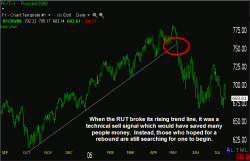One-Question Interview at StockTickr: Lessons I’ve Learned in the Downtrend
Big thanks to Dave over at StockTickr for his One-Question Interview with yours truly. Dave has interviewed me before, but this one focused on “What trading lessons I’ve learned from the downtrend that started in May,” so I was happy to oblige!
By the way, if you haven’t checked out StockTickr, you owe it to yourself to do so! It is a fantastic product and there are great updates made constantly as new ideas are implemented to provide users with even more useful trading tools, so it will be fun to see just what else it will be capable of providing as time goes on. There are also some great interviews at the StockTickr Blog which you’ll want to check out.
To expand a bit on the lessons I’ve been reminded of since May, let’s take them one at a time:
Shorts work faster than longs. Aside from my earliest days as a trader, I probably learned the most during the bear market from 2000-2003, actually doing rather well with my trading during that time. That period forced me to learn several methods of shorting stocks, and my education during that time has served me well the past couple of months. We have caught some great moves on the short side the past couple of months over at TheStockBandit.com which has allowed subscribers and me to continue finding profitable trades even though the market turned ugly. The biggest moves occur during bull markets, but some of the fastest profits come on the short side.
Trapped bulls sell into strength once the market tops out. This is what we’ve been seeing since May and even saw another round of it last week with a big rally followed by two more days of selling. Bulls who bought on the way down at perceived ‘value’ levels (valuation, schmaluation!) almost instantly saw their positions turn into losers, and as the downtrend continues it provides additional pain for them. Once a relief rally or even just a bounce begins, they are tempted to sell into the strength just to alleviate their pain and take smaller losses than what they had been facing. This essentially caps the upside of the market, and is why upside has been so limited the past couple of months.
Broken rising trend lines are significant technical events, and it’s wise to take notice whenever you see that happen. The RUT is a perfect example, as this small cap index had been leading the way during the spring making all-time highs in the process until the rising trend line was broken in May. That was a technical sell signal, and I pointed this out in The Bandit Broadcast stock newsletter when it occurred. The broken rising trend line didn’t so much start a bear market as it did end the bull run, so that was certainly a time to lighten up on long positions and start considering some short sales. It’s funny how few short candidates showed up on my screens prior to that event and how many there have been since then. That event shifted my trading bias significantly, so I’m fortunate to have placed such high importance on that trend line break. Here’s a chart with a look at the broken trend line:
Many traders lack discipline. This is not a new lesson, but I’ve recently been reminded of it. I have seen several people walk away from trading in recent weeks just because they’ve sustained losses in stocks which they refused to exit, hoping for a rebound that never came. HOPE is a 4-letter word! HOPE is not a trading strategy. If you find yourself hoping, you are wrong with at least your timing, and you’re most likely trading bigger than you should be. One other note on discipline I made to subscribers back in May is that once an uptrend ends and things begin to sour, your only logical choices are to go neutral (sit in cash) or get net short. Failing to abide by that basic principle has proved an expensive lesson for some these past two months, whereas the disciplined traders who have embraced that are sitting pretty.
The market won’t rally far without the NAZ. The NAZ has led the way lower, particularly the NAZ 100. In spite of the fact that the DJIA, RUT, and S&P 500 have all held up better than the NAZ, their upside will be limited without it. The NAZ used to be considered just a tech-heavy index that money would flow into and out of depending on the economy and modern advances. I think that now the world has changed and technology is now at the core of our world. Biotechs, semiconductors, and internets are among the most important sectors in our world today, and when those stocks trend down, it significantly handicaps the market. When those three important groups can start acting better, we’ll have much higher odds of a lasting market rally.
This market is acting a little better this week, but it’s still too early to declare that a turnaround has been made. Stay careful out there and keep in mind that even if a tradable low is being created here, it may not be smooth sailing on the way back up. If ever shortened timeframes were a good idea, it’s probably right now.
Jeff White
President, The Stock Bandit, Inc.
www.TheStockBandit.com
[tags]Stocks, Investing, Stock Trading, Technical Analysis, Trading Psychology[/tags]







